Another 10 somewhat advanced Magic: The Gathering plays
09 Dec 2017
This article contains 10 tactical edges that will win you more matches of Magic.
These plays are even more specific and esoteric than those in my previous guide, “10 somewhat advanced Magic: The Gathering plays”. And yes, now that Kaladesh is but a distant memory you will probably never cast another Fairgrounds Trumpeter for as long as you live (see Play 1 below). But the next time you encounter a card with a repeated effect that conditionally triggers during your end step, you’ll be prepared.
Don’t pass up small edges. Especially when they make you look really smart.
1. Be careful about end steps
Your opponent has a Fairgrounds Trumpeter in play, and in her hand she has a River Herald’s Boon. You are about to end your turn.
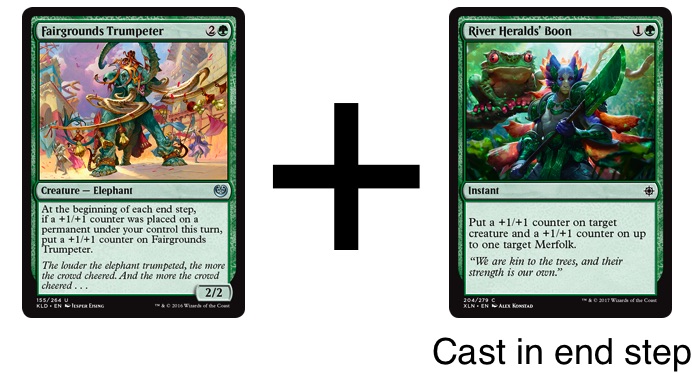
You say “Your turn”. Your opponent is a good player, and has been waiting until the end of your turn to use her instant-speed effects. She says “End step - cast River Herald’s Boon targeting my Trumpeter to give it a +1/+1 counter. The Trumpeter’s end step ability triggers and it gets another +1/+1 counter.” If this is just a friendly game at your Local Store then you should probably let her get away with this. But if you are playing in a competitive-level tournament, you should politely but firmly point out that since she cast River Herald’s Boon during your end step, the Fairground Trumpeter’s ability does not trigger. The ability reads “At the beginning of each end step, if a +1/+1 counter was put on a permanent under your control this turn, put a +1/+1 counter on Fairgrounds Trumpeter” (emphasis mine). At the beginning of your end step, the Boon had not yet been cast, so the ability’s condition was not met, and it does not trigger.
I don’t know what should happen if you say “Your turn” and your opponent simply says “Cast River Herald’s Boon” without specifying which phase she is casting it in. Should this be inferred as occurring during your end step, or at the end of your second main phase? In most situations the difference is irrelevant, but here it is critical. I would be most interested to know what a Judge would say.
2. Understanding “you may” and “target”
You have an empty board. Your opponent has a Frost Walker in play. He plays an Atzocan Archer and says “I don’t use the ability, nothing happens”.
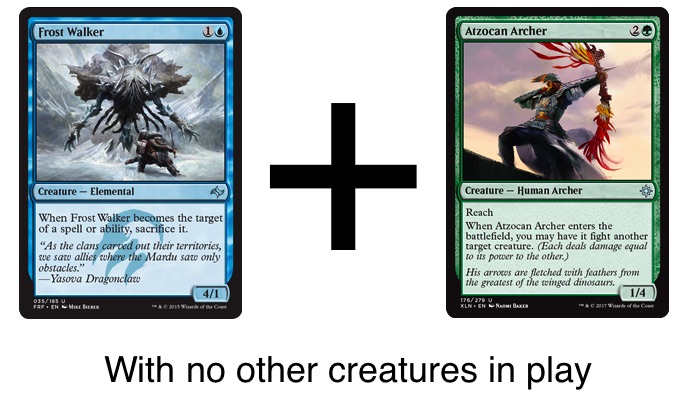
You should politely point out that whilst the “you may” clause on the Archer does mean that he has a choice about whether or not to have it do any fighting, it does not mean that he has a choice about whether or not to choose a target. Regardless of whether or not he intends to use the fight ability, he is still obliged to choose a target for it, and in this case the Frost Walker is the only legal option. Even though he can then choose to not have the Archer and the Walker fight, the Frost Walker has still been targeted, and its ability still triggers, killing it.
3. Don’t declare your choices before you have to
Your opponent has a 1/1 Priest of the Wakening Sun and several cards in hand. You have a Harnessed Lightning, and would like to kill her Priest. Unbeknowst to you, your opponent has a Giant Growth in her hand.

Harnessed Lightning reads:
Choose target creature. You get 3 Energy counters, then you may pay any amount of Energy. Harnessed Lightning deals that much damage to that creature.
According to the rules, you should say “I cast Harnessed Lightning, targeting your Priest”, without specifying how much energy you intend to spend. Since “you may pay any amount of Energy” is part of the spell’s effect, it only happens when the spell resolves. This means that you only have to choose how much energy to spend when the spell resolves, at which point there is no opportunity for your opponent to cast spells in response to your choice. She must make all of her responses without knowing how much energy you will spend.
If she uses Giant Growth to make her Priest a 4/4, you can choose to pay 0 Energy when Harnessed Lightning resolves. Her Priest survives, but you gain 3 Energy you might not have if you thought you were obliged to choose how much damage to deal at the time of casting the spell.
This knowledge can be used for angle-shooting. If you suspect that your opponent has a +2/+2 pump spell like Vampire’s Zeal, you can cast Harnessed Lightning on a 1/1, prematurely declaring “I pay 1 Energy”. If she responds by pumping her 1/1 up to a 3/3, you can correctly claim that your previous choice is no longer binding. You can then instead choose to pay 3 Energy, and her creature will still die, despite having been pumped. This is all completely legal, albeit a little too vicious for my tastes, even at a competitive level event. You should be sure to protect yourself from being on the wrong end of it.
4. Don’t declare your choices before you have to, part II
You have a Flametongue Kavu and 2 Shocks. Your opponent has a 5/5 Charging Monstrosaur, a 2/2 Glory Seeker, and you suspect that he also has a Cancel in his hand. You want to kill his Monstrosaur by hitting it with 4 damage from the Kavu and another 2 damage from a Shock.

You should not say “I cast Flametongue Kavu, shooting your Monstrosaur”. Your opponent will realize that something is up. Your obvious play would have been for to kill his 2/2, and he will infer that you must have additional ways to damage and kill the Monstrosaur in your hand. He will probably Cancel your Kavu, and you will be unable to kill his Monstrosaur.
Instead, you should remember that you don’t have to declare targets for the Kavu’s Enter-The-Battlefield (ETB) trigger until the Kavu has resolved and actually entered the battlefield. You should say “I cast Flametongue Kavu”, and wait for your opponent to decide whether to counter it or not. When it resolves, its ETB trigger goes on the stack, and only then do you need to declare that you are targeting the Monstrosaur for 4 damage. Even if your opponent realizes that you are up to something, it’s too late for him to counter the Kavu. He can counter your follow up Shock, of course, but that’s why I gave you 2 of them.
5. Incremental firebreathing
You are attacking with a Fathom Fleet Firebrand, and your opponent has chosen not to block. You have 6 mana untapped and would like to pump the Firebrand 3 times. Unbeknowst to you, your opponent has a Vanquish the Weak in her hand and would like to kill your Firebrand.
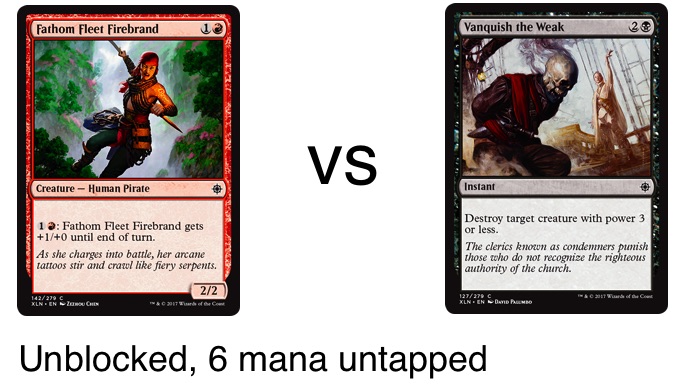
You should not say “pay 6, pump the Firebrand 3 times.” By placing all of the abilities on the stack at once, you reveal your entire plan up front, and give your opponent a completely free choice of exactly where to interject her instant-speed effects. If she has a Vanquish the Weak, she can play it immediately, before any of your pumps resolve. Your Firebrand will still have 2 power as the Vanquish resolves, and it will die.
Instead, you should say “pay 2, pump the Firebrand once” and wait for your opponent to allow this to resolve. Then do it again: “pay 2, pump the Firebrand once” and wait for this to resolve. Finally, one more time, “pay 2, pump the Firebrand once”. When you sequence your pumps in this way, your opponent cannot successfully resolve Vanquish the Weak. If she plays it in response to the first pump, you pump twice more in response to get it to 4 power and out of range. If she plays it in response to the second pump, you pump once more to again get it to 4 power by the time the Vanquish resolves. And by the time you get to the third pump, the Firebrand already has 4 power and cannot be targeted by Vanquish at all.
6. Make sure your opponent orders blockers at the right time
Your opponent attacks you with some of his creatures, and you block with some of yours. Some of your blocks are double- and triple-blocks.
Some opponents will immediately try to resolve damage, cast some spells or activate some effects. You should politely ask them to first declare the order in which he wishes to assign damage to your creatures in the multi-blocks. It’s important to ensure that he makes this choice before you reveal any information about any pre-damage effects you may or may not have, since any information you reveal may cause him to change his ordering. Whilst many less experienced players are aware that they have to choose an order, there can be legitimate, non-malicious confusion about exactly when they must make this choice.
7. Responding to enter the battlefield triggers
You are at 1 life. You have a Lightning Strike in your hand. Both you and your opponent have empty boards. Your opponent topdecks and casts Bishop of the Bloodstained. She says “Bishop drains you for 1, you die, good game.” She offers her hand for a consolation shake.
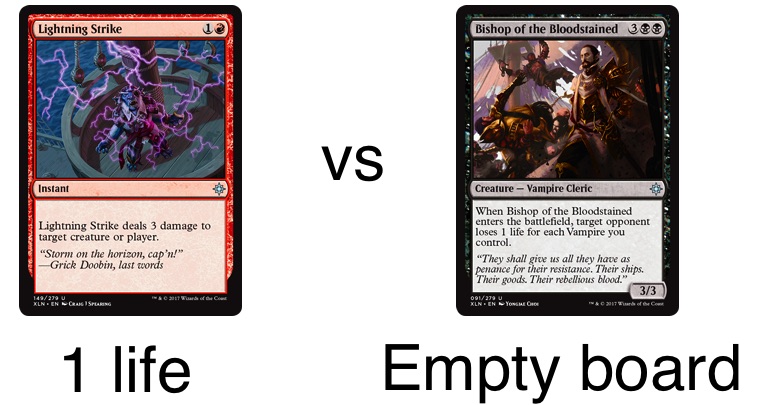
After a long, tense game, it would be very easy to sigh, shake your opponent’s hand, sign the match slip and moan to your friends about how stupid Magic is. However, you should first pause to double-check your opponent’s calculations. When the Bishop enters the battlefield, its ETB trigger goes on the stack. At this point you have the opportunity to Lightning Strike the Bishop, meaning that when the ETB actually trigger resolves your opponent controls 0 vampires, you lose 0 life, and you are still in the game.
This may seem straightforward, but I recently lost a game in this way, and I have a sufficiently inflated opinion of my skills as a Magic player to write an entire article about somewhat advanced Magic plays. For some reason I think this is a much less obvious play than if you were at 2 life and your opponent already controlled another Vampire, in addition to the newly-cast Bishop. In this situation most players would have no problem seeing that they should kill their opponent’s other Vampire, saving themselves 1 crucial point of life.
8. Responding to enter the battlefield triggers, part II
Your opponent has 0 Energy counters, and has just cast an Aethertide Whale. You have an Unfriendly Fire. The Whale is still on the stack. You desperately want to kill it.
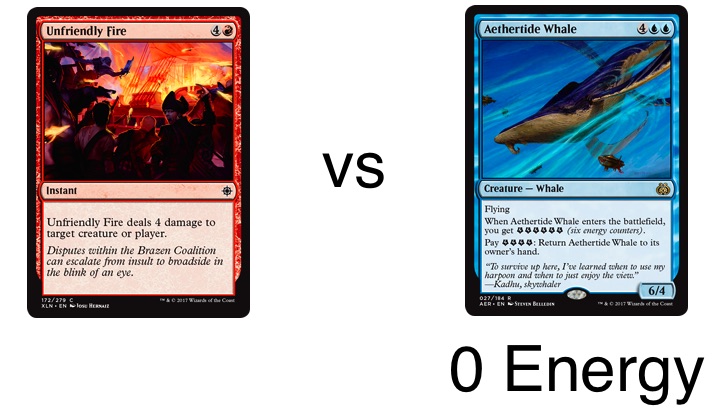
In this situation it is very tempting to rage-scoop and start complaining about what a stupid broken bomb Aethertide Whale is, since as soon as it enters the battlefield your opponent gains enough energy to bounce it back to his hand, making it essentially invincible. However, much like in the previous example, there is a short gap between the Whale entering the battlefield and your opponent actually getting the energy from its ETB trigger. When the Whale resolves, its ETB trigger goes onto the stack. Since your opponent currently has 0 Energy, you can Unfriendly Fire it in response to the trigger. Your spell will resolve before his trigger, and the Whale will die. He will still gain 6 Energy, but he will get it too late to save his Whale.
This opportunity can be easy to miss, especially if your opponent moves too fast and ticks up his Energy count as soon as he casts the Whale, before you have had a chance to think. You should never feel bad about asking an opponent to slow down a little and making sure you have the opportunity to interject at the right moments.
9. There is an “End of Combat” Step
Your opponent is attacking you with a 5/5 Charging Monstrosaur and a 2/2 Glory Seeker. You have a Glory Seeker of your own in play, and a Celestial Flare in your hand.
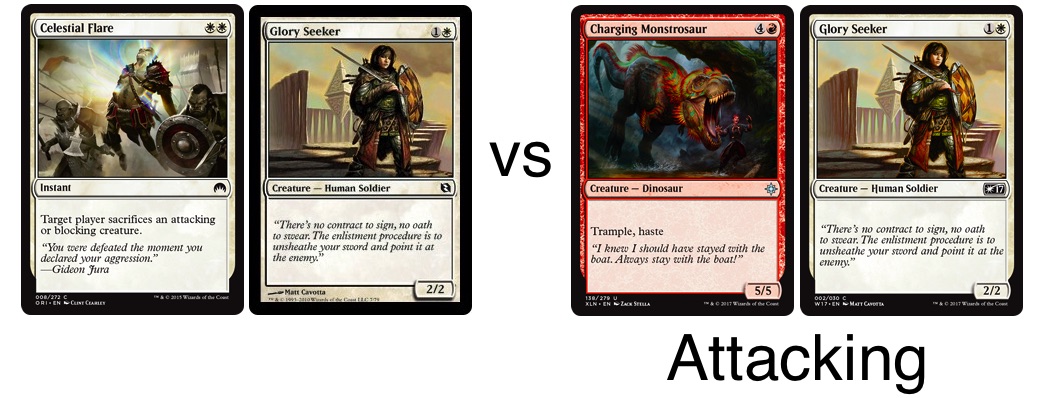
You should let the Monstrosaur through, block her Glory Seeker with your own, and allow the Seekers to trade in the Combat Damage Step. Then, during the oft-forgotten End of Combat Step, you should cast Celestial Flare. Since you are still technically in the Combat Phase, your opponent’s Monstrosaur still counts as attacking. Since you waited until her Seeker died before casting Celestial Flare, the Monstrosaur is her only attacking creature, and she is forced to sacrifice it. If you had cast the Flare at any other point during combat, your opponent would have calmly sacrificed her Glory Seeker, and you would have still been facing down an angry trampling dinosaur.
10. There is an “End of Combat” Step part II
Your opponent is attacking you with a 3/3 lifelinking Queen’s Agent. You have a 2/2 Glory Seeker and a Slash of Talons. You would like to block his Queen’s Agent with your Glory Seeker, and use Slash of Talons to finish it off. You are concerned that he might have a Vampire’s Zeal to save his Agent, but you are willing to run this risk.
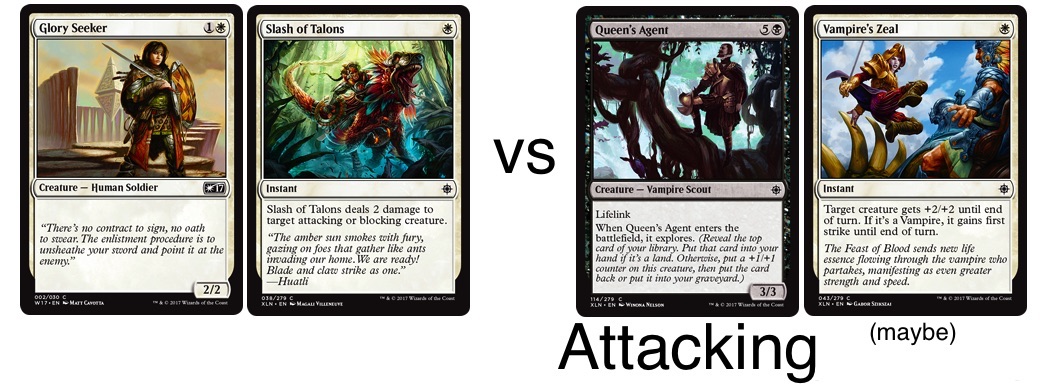
You should block his Agent with your Seeker. Once your opponent passes priority during the Declare Blockers Step, it is tempting to immediately cast Slash of Talons. You hope that it will do its 2 damage, then, if your opponent doesn’t have Vampire’s Zeal, your Seeker will do another 2 damage to finish it off. However, if he does have it, his Zealed-up Agent will survive and deal a total of 5 damage, gaining them 5 life.
You should instead consider letting the Combat Damage Step happen, and only casting Slash of Talons on his still-attacking Agent during the End of Combat step. If he does have Vampire’s Zeal then his Agent still survives, but because you waited until after it had dealt combat damage, it only dealt 3 damage and only gained them 3 life.
11. BONUS - There is a pause after first-strike damage
Your opponent is attacking you with a 3/2 first striking Emissary of Sunrise and a 2/2 Glory Seeker. You have a 1/1 Eager Cadet, and a Vampire’s Zeal in your hand. You would like to let through the Emissary, block her Seeker with your Cadet, and cast Vampire’s Zeal on your Cadet in order to save it and kill her Seeker. You know that she has a Sure Strike in her deck, and are concerned that she might use it to turn her Seeker into a 5/2 with first strike, saving it and killing your 3/3 Cadet.

You should block her Seeker with your Cadet, and wait for the Emissary to deal its damage in the First-Strike Damage Step. Only now, before normal damage, should you cast your Vampire’s Zeal on your Cadet. She can still cast Sure Strike on her Seeker in response, but since first strike damage has already happened, it will deal its damage during the Normal Damage Step, at the same time as your Cadet. The creatures will trade.
Note that this only works if there is a creature with first strike involved in combat. If there is not, then when your opponent casts Sure Strike, the first strike damage step will not yet have been scheduled or skipped. Her now first striking Seeker will get to deal its damage in the newly scheduled First Strike Damage Step, and your Cadet will die for nothing.
I have described these 11 situations as “somewhat advanced plays”. But most of them are actually nothing more than properly understanding some of the more offbeat rules of Magic. This understanding allows you to see the value in lines of play that a less experienced player might have missed, and helps you make sure that you don’t allow your opponents to misapply the rules to their advantage, accidentally or otherwise.
The rules of Magic say that you aren’t obliged to point out your opponent’s triggers, especially in competitive events. If your opponent forgets to gain 1 life from Soul Warden whenever a creature comes into play, that’s their loss. But you are obliged to attempt to administer the game according to your best understanding of the rules. If the only creature in play is your Frost Walker and you cast an Atzocan Archer, don’t wait for your opponent to point out that you need to target and kill your own creature. Don’t try and delay ordering blockers in order to extract information, and don’t try and claim end step triggers you aren’t technically entitled to. Use your deep understanding of the rules to make better plays than your opponent. Don’t use it to try and dupe them.
If you enjoyed this post, then I guarantee you will also enjoy “10 somewhat advanced Magic: The Gathering plays”. And if you have any advanced plays of your own that I’ve missed, let me know!
This article contains 10 tactical edges that will win you more matches of Magic.
These plays are even more specific and esoteric than those in my previous guide, “10 somewhat advanced Magic: The Gathering plays”. And yes, now that Kaladesh is but a distant memory you will probably never cast another Fairgrounds Trumpeter for as long as you live (see Play 1 below). But the next time you encounter a card with a repeated effect that conditionally triggers during your end step, you’ll be prepared.
Don’t pass up small edges. Especially when they make you look really smart.
1. Be careful about end steps
Your opponent has a Fairgrounds Trumpeter in play, and in her hand she has a River Herald’s Boon. You are about to end your turn.

You say “Your turn”. Your opponent is a good player, and has been waiting until the end of your turn to use her instant-speed effects. She says “End step - cast River Herald’s Boon targeting my Trumpeter to give it a +1/+1 counter. The Trumpeter’s end step ability triggers and it gets another +1/+1 counter.” If this is just a friendly game at your Local Store then you should probably let her get away with this. But if you are playing in a competitive-level tournament, you should politely but firmly point out that since she cast River Herald’s Boon during your end step, the Fairground Trumpeter’s ability does not trigger. The ability reads “At the beginning of each end step, if a +1/+1 counter was put on a permanent under your control this turn, put a +1/+1 counter on Fairgrounds Trumpeter” (emphasis mine). At the beginning of your end step, the Boon had not yet been cast, so the ability’s condition was not met, and it does not trigger.
I don’t know what should happen if you say “Your turn” and your opponent simply says “Cast River Herald’s Boon” without specifying which phase she is casting it in. Should this be inferred as occurring during your end step, or at the end of your second main phase? In most situations the difference is irrelevant, but here it is critical. I would be most interested to know what a Judge would say.
2. Understanding “you may” and “target”
You have an empty board. Your opponent has a Frost Walker in play. He plays an Atzocan Archer and says “I don’t use the ability, nothing happens”.

You should politely point out that whilst the “you may” clause on the Archer does mean that he has a choice about whether or not to have it do any fighting, it does not mean that he has a choice about whether or not to choose a target. Regardless of whether or not he intends to use the fight ability, he is still obliged to choose a target for it, and in this case the Frost Walker is the only legal option. Even though he can then choose to not have the Archer and the Walker fight, the Frost Walker has still been targeted, and its ability still triggers, killing it.
3. Don’t declare your choices before you have to
Your opponent has a 1/1 Priest of the Wakening Sun and several cards in hand. You have a Harnessed Lightning, and would like to kill her Priest. Unbeknowst to you, your opponent has a Giant Growth in her hand.

Harnessed Lightning reads:
Choose target creature. You get 3 Energy counters, then you may pay any amount of Energy. Harnessed Lightning deals that much damage to that creature.
According to the rules, you should say “I cast Harnessed Lightning, targeting your Priest”, without specifying how much energy you intend to spend. Since “you may pay any amount of Energy” is part of the spell’s effect, it only happens when the spell resolves. This means that you only have to choose how much energy to spend when the spell resolves, at which point there is no opportunity for your opponent to cast spells in response to your choice. She must make all of her responses without knowing how much energy you will spend.
If she uses Giant Growth to make her Priest a 4/4, you can choose to pay 0 Energy when Harnessed Lightning resolves. Her Priest survives, but you gain 3 Energy you might not have if you thought you were obliged to choose how much damage to deal at the time of casting the spell.
This knowledge can be used for angle-shooting. If you suspect that your opponent has a +2/+2 pump spell like Vampire’s Zeal, you can cast Harnessed Lightning on a 1/1, prematurely declaring “I pay 1 Energy”. If she responds by pumping her 1/1 up to a 3/3, you can correctly claim that your previous choice is no longer binding. You can then instead choose to pay 3 Energy, and her creature will still die, despite having been pumped. This is all completely legal, albeit a little too vicious for my tastes, even at a competitive level event. You should be sure to protect yourself from being on the wrong end of it.
4. Don’t declare your choices before you have to, part II
You have a Flametongue Kavu and 2 Shocks. Your opponent has a 5/5 Charging Monstrosaur, a 2/2 Glory Seeker, and you suspect that he also has a Cancel in his hand. You want to kill his Monstrosaur by hitting it with 4 damage from the Kavu and another 2 damage from a Shock.

You should not say “I cast Flametongue Kavu, shooting your Monstrosaur”. Your opponent will realize that something is up. Your obvious play would have been for to kill his 2/2, and he will infer that you must have additional ways to damage and kill the Monstrosaur in your hand. He will probably Cancel your Kavu, and you will be unable to kill his Monstrosaur.
Instead, you should remember that you don’t have to declare targets for the Kavu’s Enter-The-Battlefield (ETB) trigger until the Kavu has resolved and actually entered the battlefield. You should say “I cast Flametongue Kavu”, and wait for your opponent to decide whether to counter it or not. When it resolves, its ETB trigger goes on the stack, and only then do you need to declare that you are targeting the Monstrosaur for 4 damage. Even if your opponent realizes that you are up to something, it’s too late for him to counter the Kavu. He can counter your follow up Shock, of course, but that’s why I gave you 2 of them.
5. Incremental firebreathing
You are attacking with a Fathom Fleet Firebrand, and your opponent has chosen not to block. You have 6 mana untapped and would like to pump the Firebrand 3 times. Unbeknowst to you, your opponent has a Vanquish the Weak in her hand and would like to kill your Firebrand.

You should not say “pay 6, pump the Firebrand 3 times.” By placing all of the abilities on the stack at once, you reveal your entire plan up front, and give your opponent a completely free choice of exactly where to interject her instant-speed effects. If she has a Vanquish the Weak, she can play it immediately, before any of your pumps resolve. Your Firebrand will still have 2 power as the Vanquish resolves, and it will die.
Instead, you should say “pay 2, pump the Firebrand once” and wait for your opponent to allow this to resolve. Then do it again: “pay 2, pump the Firebrand once” and wait for this to resolve. Finally, one more time, “pay 2, pump the Firebrand once”. When you sequence your pumps in this way, your opponent cannot successfully resolve Vanquish the Weak. If she plays it in response to the first pump, you pump twice more in response to get it to 4 power and out of range. If she plays it in response to the second pump, you pump once more to again get it to 4 power by the time the Vanquish resolves. And by the time you get to the third pump, the Firebrand already has 4 power and cannot be targeted by Vanquish at all.
6. Make sure your opponent orders blockers at the right time
Your opponent attacks you with some of his creatures, and you block with some of yours. Some of your blocks are double- and triple-blocks.
Some opponents will immediately try to resolve damage, cast some spells or activate some effects. You should politely ask them to first declare the order in which he wishes to assign damage to your creatures in the multi-blocks. It’s important to ensure that he makes this choice before you reveal any information about any pre-damage effects you may or may not have, since any information you reveal may cause him to change his ordering. Whilst many less experienced players are aware that they have to choose an order, there can be legitimate, non-malicious confusion about exactly when they must make this choice.
7. Responding to enter the battlefield triggers
You are at 1 life. You have a Lightning Strike in your hand. Both you and your opponent have empty boards. Your opponent topdecks and casts Bishop of the Bloodstained. She says “Bishop drains you for 1, you die, good game.” She offers her hand for a consolation shake.

After a long, tense game, it would be very easy to sigh, shake your opponent’s hand, sign the match slip and moan to your friends about how stupid Magic is. However, you should first pause to double-check your opponent’s calculations. When the Bishop enters the battlefield, its ETB trigger goes on the stack. At this point you have the opportunity to Lightning Strike the Bishop, meaning that when the ETB actually trigger resolves your opponent controls 0 vampires, you lose 0 life, and you are still in the game.
This may seem straightforward, but I recently lost a game in this way, and I have a sufficiently inflated opinion of my skills as a Magic player to write an entire article about somewhat advanced Magic plays. For some reason I think this is a much less obvious play than if you were at 2 life and your opponent already controlled another Vampire, in addition to the newly-cast Bishop. In this situation most players would have no problem seeing that they should kill their opponent’s other Vampire, saving themselves 1 crucial point of life.
8. Responding to enter the battlefield triggers, part II
Your opponent has 0 Energy counters, and has just cast an Aethertide Whale. You have an Unfriendly Fire. The Whale is still on the stack. You desperately want to kill it.

In this situation it is very tempting to rage-scoop and start complaining about what a stupid broken bomb Aethertide Whale is, since as soon as it enters the battlefield your opponent gains enough energy to bounce it back to his hand, making it essentially invincible. However, much like in the previous example, there is a short gap between the Whale entering the battlefield and your opponent actually getting the energy from its ETB trigger. When the Whale resolves, its ETB trigger goes onto the stack. Since your opponent currently has 0 Energy, you can Unfriendly Fire it in response to the trigger. Your spell will resolve before his trigger, and the Whale will die. He will still gain 6 Energy, but he will get it too late to save his Whale.
This opportunity can be easy to miss, especially if your opponent moves too fast and ticks up his Energy count as soon as he casts the Whale, before you have had a chance to think. You should never feel bad about asking an opponent to slow down a little and making sure you have the opportunity to interject at the right moments.
9. There is an “End of Combat” Step
Your opponent is attacking you with a 5/5 Charging Monstrosaur and a 2/2 Glory Seeker. You have a Glory Seeker of your own in play, and a Celestial Flare in your hand.

You should let the Monstrosaur through, block her Glory Seeker with your own, and allow the Seekers to trade in the Combat Damage Step. Then, during the oft-forgotten End of Combat Step, you should cast Celestial Flare. Since you are still technically in the Combat Phase, your opponent’s Monstrosaur still counts as attacking. Since you waited until her Seeker died before casting Celestial Flare, the Monstrosaur is her only attacking creature, and she is forced to sacrifice it. If you had cast the Flare at any other point during combat, your opponent would have calmly sacrificed her Glory Seeker, and you would have still been facing down an angry trampling dinosaur.
10. There is an “End of Combat” Step part II
Your opponent is attacking you with a 3/3 lifelinking Queen’s Agent. You have a 2/2 Glory Seeker and a Slash of Talons. You would like to block his Queen’s Agent with your Glory Seeker, and use Slash of Talons to finish it off. You are concerned that he might have a Vampire’s Zeal to save his Agent, but you are willing to run this risk.

You should block his Agent with your Seeker. Once your opponent passes priority during the Declare Blockers Step, it is tempting to immediately cast Slash of Talons. You hope that it will do its 2 damage, then, if your opponent doesn’t have Vampire’s Zeal, your Seeker will do another 2 damage to finish it off. However, if he does have it, his Zealed-up Agent will survive and deal a total of 5 damage, gaining them 5 life.
You should instead consider letting the Combat Damage Step happen, and only casting Slash of Talons on his still-attacking Agent during the End of Combat step. If he does have Vampire’s Zeal then his Agent still survives, but because you waited until after it had dealt combat damage, it only dealt 3 damage and only gained them 3 life.
11. BONUS - There is a pause after first-strike damage
Your opponent is attacking you with a 3/2 first striking Emissary of Sunrise and a 2/2 Glory Seeker. You have a 1/1 Eager Cadet, and a Vampire’s Zeal in your hand. You would like to let through the Emissary, block her Seeker with your Cadet, and cast Vampire’s Zeal on your Cadet in order to save it and kill her Seeker. You know that she has a Sure Strike in her deck, and are concerned that she might use it to turn her Seeker into a 5/2 with first strike, saving it and killing your 3/3 Cadet.

You should block her Seeker with your Cadet, and wait for the Emissary to deal its damage in the First-Strike Damage Step. Only now, before normal damage, should you cast your Vampire’s Zeal on your Cadet. She can still cast Sure Strike on her Seeker in response, but since first strike damage has already happened, it will deal its damage during the Normal Damage Step, at the same time as your Cadet. The creatures will trade.
Note that this only works if there is a creature with first strike involved in combat. If there is not, then when your opponent casts Sure Strike, the first strike damage step will not yet have been scheduled or skipped. Her now first striking Seeker will get to deal its damage in the newly scheduled First Strike Damage Step, and your Cadet will die for nothing.
I have described these 11 situations as “somewhat advanced plays”. But most of them are actually nothing more than properly understanding some of the more offbeat rules of Magic. This understanding allows you to see the value in lines of play that a less experienced player might have missed, and helps you make sure that you don’t allow your opponents to misapply the rules to their advantage, accidentally or otherwise.
The rules of Magic say that you aren’t obliged to point out your opponent’s triggers, especially in competitive events. If your opponent forgets to gain 1 life from Soul Warden whenever a creature comes into play, that’s their loss. But you are obliged to attempt to administer the game according to your best understanding of the rules. If the only creature in play is your Frost Walker and you cast an Atzocan Archer, don’t wait for your opponent to point out that you need to target and kill your own creature. Don’t try and delay ordering blockers in order to extract information, and don’t try and claim end step triggers you aren’t technically entitled to. Use your deep understanding of the rules to make better plays than your opponent. Don’t use it to try and dupe them.
If you enjoyed this post, then I guarantee you will also enjoy “10 somewhat advanced Magic: The Gathering plays”. And if you have any advanced plays of your own that I’ve missed, let me know!